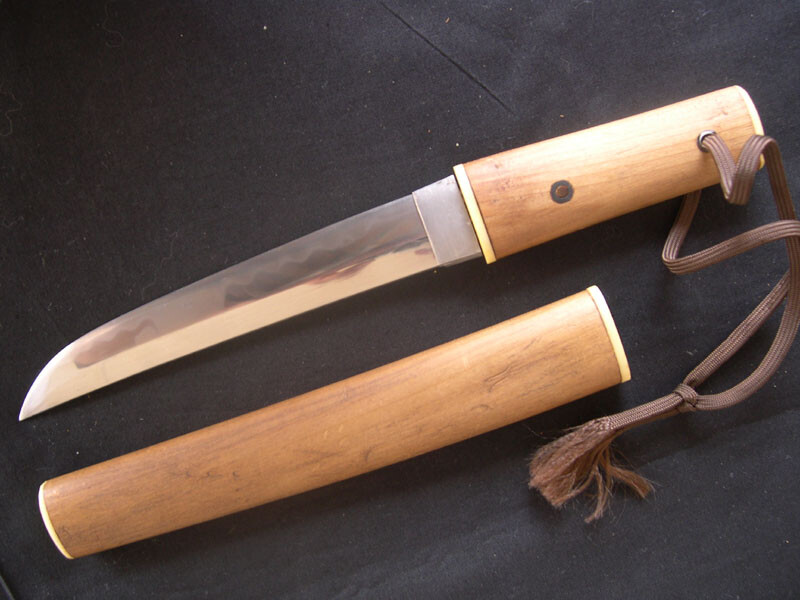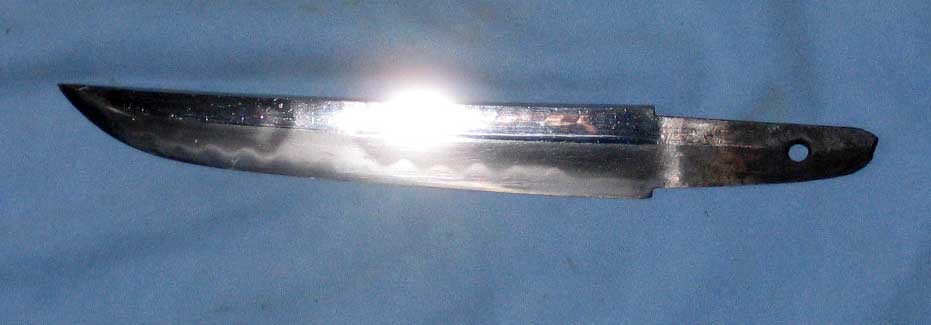-
Posts
7,353 -
Joined
-
Last visited
-
Days Won
96
Content Type
Profiles
Forums
Events
Store
Downloads
Gallery
Everything posted by Ken-Hawaii
-
Mike, do you have the construction drawings for this rack? I'm assuming you built it yourself. If you're willing to send them to me, I'll convert them into several formats that everyone can use, & send them to anyone who asks. There's lots of beautiful woods out here in Hawaii (koa, milo, etc.), & I've been looking for a new rack design to install in my sword case. Thanks in advance.
-
Well, if you have to hit another blade, the mune is definitely the best target. It's usually about 1/10 as hard as the ha....
-
Or you can be lucky as I was & get the origami back in five days. Not sure how things happened so fast, but I certainly wasn't complaining! :D
-
Charles, if you're out here in Hawaii, drop me an e-mail (iaido@catii.com) & I'll help you find a way to get the repairs done locally. Bob Benson is very good, but is so busy that he hasn't finished one of my projects. There's another good togishi who's a lot easier to get to. I'm in Kaneohe, so if you're out at MCBH, it'll be easy to get together. A flaw is fatal only if you're planning to either use or sell the o-wakizashi, of course, but I realize that no one likes to get a new Nihonto that our wonderful mail system has mauled....
-
Repairing a saya is really no fun at all, Mike. I suggest sending out to your favorite sword shop to let them handle that work. If your saya is actively used with an iaito, I suggest having them wrap the top six inches (closest to the koiguchi) with bamboo. I had mine done that way several years ago, & it's worked wonders with my noto & sayabiki. But if you're really a glutton for punishment, here are some links I've found for saya repairs: http://ejmas.com/tin/2005tin/tinart_forbes_0105.html http://ejmas.com/tin/tinart_fowler_0602.htm http://www.britishblades.com/home/artic ... article=29
-
I guess I'm lucky that I live in Hawaii where the temperature & humidity almost never change. :D My son (a meteorologist) recently moved his family out here, & has been commenting that there's only a few degrees difference between July & December temperatures (less than five). And virtually no change in humidity. Jean, I use a Golden Rod dehumidifier (http://www.dealerease.net/catalog/product.asp?pid=5506&ret_id=139995) in my safes & especially in my Nihonto case. It does a great job of keeping the humidity down around 12%, while the ambient humidity averages 55%. I've obviously never had any problems with things drying out here, but when I lived in Laramie, Wyoming (elevation 7200 feet), almost all the wood items I had shrank & cracked. There were times when I couldn't pull my iaito from its saya! Jeremy, you might have your friend put his sword into a water-tight box with a small amount of water in a bowl; that should loosen things up. But of course be sure that he has first oiled everything he can reach!
-
Aloha, Bill: While we on this forum can perhaps help you with Nihonto, I'm sure that you - with your many years of collecting other weapons - can help most of us with ideas & techniques to prevent our being defrauded. Welcome aboard.
-

You have to love it......who wouldn't like to have it....
Ken-Hawaii replied to Jock's topic in Nihonto
Gorgeous!! Wish my Bizen katana looked like that.... -
For that price, you'd think we'd get at least Juyo, or even Juyo Tokubetsu! I guess some people have more money than selectivity.
-
Absolutely gorgeous job, Rich! I doubt that I would have had your same level of belief that the blade could have been reshaped & restored that well. I'm curious whether the restoration of the kissaki was done by the same togishi who polished it? And if you could provide a rough estimate of cost, I'm sure there are a lot of us who would benefit. I know togishi pricing, but have no clue on the cost of reshaping the kissaki. Thanks!
-
Just saw your posting, Mike. Three of our sword society members travel around as a shinsa team, I believe for NBTHK, but I'm not positive; could be NTHK. We're really lucky to have them in the club! Most of what they say has to be translated for me, as my Japanese is fairly limited.... When we're even luckier, they bring in a Juyo-level blade for kantei. Quite a learning experience. Anyway, my shirasaya doesn't look that old, but he was pretty firm on what he told me. The blade is somewhat loose in the shirasaya, so I guess it's possible that the tanto was just mounted into it. There is a second hole in the saya that doesn't correspond to the nakago's single mekugiana, as the nakago is shorter. There is a very slight itame grain to the hada, but I couldn't quite call it muji; almost need a magnifying glass to see it, though. No specific hataraki that I can see, although there's definitely nie activity. The shinsa members may all attend next month's meeting, but will definitely be there in September, so I can report back on what they tell me.
-
Steve, I can see some similarities to that WWII dagger, but also some significant differences. The nakago on my blade is ubu, according to the shinsa & the other sword society members. The rust is much deeper than could be formed since WWII. The blade shape is also indicative of an older forging.
-
No, Logan, I'd say about $40K a year is just about right for this hobby....
-
Hey, don't forget that gimei blades make excellent letter-openers!
-
I'm looking forward to climbing Fuji-san some year, Henry. I envy you being in sight of it. We don't get to visit Japan as often now that our son & his Japanese wife live out here in Hawaii. Talk about mixed blessings.... I left out one part of our shinsa's translation: he thinks the hamon on the other side just may be an interpretation of one of the Black Ships. I think the swordsmith was having way too much fun! :D
-
Pete, I did the tracing by inserting the scaled photographs of the tanto into AutoCAD, & then first carefully followed the outline with a polyline, & then did the same with the hamon. A little tedious, but very accurate. I just returned from our local monthly Japanese Sword Society meeting, & one of the three shinsa members was there. He was enthralled with the blade, & had his magnifying glass on it a good part of the meeting. His opinion is that it's a Shin-shinto blade, possibly made by a swordsmith from the Soshu school. He's fairly sure that the hamon is intentional, & is likely of Fuji-san. He even took some photos to research. I haven't seen him so excited since a member brought in a Juyo Token blade last year. Next month, all three shinsa members are supposed to attend our meeting, & I hope to get a provenance consensus from them. Interestingly, the shirasaya, which I thought was modern capped with cheap plastic, may be older than the tanto, & the caps are definitely ivory.
-
Okay, now that I have this tanto in hand, I've had a chance to take a much closer look...& I still don't quite know what the swordsmith did when he created it. I've attached two photos, along with a tracing I did of the hamon. There's enough detail that I don't think that the clay slipped; seems more planned than anything else. Does everyone still think this is a WWII kamikaze dagger?
-
He's advertising that saber all over, as it's also shown up out in here in Hawaii.
-
Guido, thanks for the clarification on blade length terminology. I'll admit never having heard of zencho, but of the 20 or so Nihonto I own, every one had the overall length and nagasa length specified. I thus thought it was fairly standard, even in Japan where I bought about half my collection. As an iaidoka long before I started collecting, the length of the tsuka (& underlying nakago) is a major factor in choosing a weapon to swing. So please forgive me if that practical interest has made its way over to Nihonto. :D
-
Hi, Guido. I also don't read Japanese, & so wasn't able to interpret how Aoi defined as their blade length. But I also want to know the entire length of the sword = nagasa + nakago, not just one of the two, especially if I'm shelling out a few thousand dollars.
-
The only thing I don't like about Aoi is that they never make quite clear exactly what they mean by "blade length." Blade length to me means the nagasa, whereas sometimes Aoi means the entire length of the sword. If they don't mean the nagasa length, just how are you supposed to tell how long the cutting edge is, or, conversely, the total length of the sword?? Andreas, your choice seems to be a good one for the money. But I'm a tad confused when you mention the length of the ha, which is the area between the actual cutting edge & the top of the hamon. Am I missing something, or did you really mean the nagasa length (66.66 cm), or whatever they mean by "blade length" here?
-
I'm guessing that he meant "ware" instead of "wale," Mike. :? They are horizontal "lines" (splits) generally due to a poor weld between layers of steel, & can occur anywhere on the blade. Not sure about the "masa" part. Nothing in my references about "sumi-kogori," either. :? Probably should have had those clarified before you bought it; has the blade arrived there yet? I'll have to get to my books later to check on the swordsmith.
-
Rod, I think I would at least communicate with him to find out WHY he left off his signature. Mark does have a good point that Japanese swordsmiths still have a limit of three Nihonto per month, so that may be a limiting factor on whether he can/will sign his mei.
-
Looks like a pretty decent stand, Henry, but it might not be appropriate for your tanto. Maybe I'm old-fashioned, but if you're displaying a blade, why in the world would you want to leave it in koshirae? It makes a lot more sense to me to display the blade by itself on the top level, with a lower support for the koshirae. That's certainly what I do for my Nihonto. If the blade is in shirasaya, it's a toss-up whether you want to just lay the shirasaya flat in front of the katanakake, with the blade on the single support. There are actually some good reasons for displaying Nihonto this way. Shirasaya tend to collect humidity, which doesn't do much good for the blade. And if you have the whole assembly in a climate-controlled case (I use a Dry-Rod), then the blade has much less chance to rust. Anyway, to answer your question, yes, it's okay to have the tsuka touching the katanakake support. For longer blades, however, the support may end up in front of the tsuka & tsuba, with the mune of the nagasa lying on the support.
-
I bought that tanto, Stephen, & it's being shipped from the East Coast today. I'll post some photos when it arrives. I just checked my PM, but don't see anything from you. Sorry about that.





